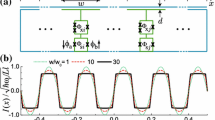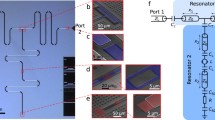Abstract
In this paper we propose a kind of quantum inductance couplers (QUINC) which represents a superconducting loop closed by ScS quantum point contact, operating in deep quantum low-temperature regime to provide tunable (Ising-type) ZZ interaction between flux qubits. This coupler is shown to be well tunable by an external control magnetic flux and to provide large inter-qubit interaction energies \(|J/k_{\rm B}|\simeq1~\mathrm{K}\) thus being very promising as a qubit-coupling device in a quantum register as well as for studying fundamental low-temperature quantum phenomena. Some entanglement measures of a two-qubit system are analyzed as functions of inter-qubit interaction strength.





Similar content being viewed by others
References
A. Steane, Quantum computing. Rep. Prog. Phys. 61, 117–173 (1998). arXiv:quant-ph/9708022v2
S.Y. Kilin, Quantum information. Phys. Usp. 42, 435–452 (1999)
K.A. Valiev, Quantum computers and quantum computations. Phys. Usp. 48, 1–36 (2005)
J.L. Brylinski, R. Brylinski, Universal quantum gates, in Mathematics of Quantum Computation (Chapman and Hall/CRC Press, London, 1994), p. 124. arXiv:quant-ph/0108062v1
A. Barenco, C.H. Bennett, R. Cleve, D.P. DiVincenzo, N. Margolus, P. Shor, T. Sleator, J.A. Smolin, H. Weinfurter, Elementary gates for quantum computation. Phys. Rev. A 52, 3457 (1995)
L.H. Kauffman, S.J. Lomonaco, Braiding operators are universal quantum gates. New J. Phys. 6, 134 (2004)
D.P. DiVincenzo, The physical implementation of quantum computation. Fortschr. Phys. 48, 771 (2000)
J. Clarke, F.K. Wilhelm, Superconducting quantum bits. Nature 453, 1031 (2008)
A. Izmalkov, M. Grajcar, E. Il’ichev, Th. Wagner, H.-G. Meyer, A.Yu. Smirnov, M.H.S. Amin, A.M. van den Brink, A.M. Zagoskin, Evidence for entangled states of two coupled flux qubits. Phys. Rev. Lett. 93, 037003 (2004)
J.B. Majer, F.G. Paauw, A.C.J. ter Haar, C.J.P.M. Harmans, J.E. Mooij, Spectroscopy on two coupled superconducting flux qubits. Phys. Rev. Lett. 94, 090501 (2005)
B.L.T. Plourde, J. Zhang, K.B. Whaley, F.K. Wilhelm, T.L. Robertson, T. Hime, S. Linzen, P.A. Reichardt, C.-E. Wu, J. Clarke, Entangling flux qubits with a bipolar dynamic inductance. Phys. Rev. B 70, 140501(R) (2004)
A.M. van den Brink, A.J. Berkley, M. Yalowsky, Mediated tunable coupling of flux qubits. New J. Phys. 7, 230 (2005)
M.J. Storcz, F.K. Wilhelm, Design of realistic switches for coupling superconducting solid-state qubits. Appl. Phys. Lett. 83, 2387 (2003)
T. Hime, P.A. Reichardt, B.L.T. Plourde, T.L. Robertson, C.-E. Wu, A.V. Ustinov, J. Clarke, Solid-state qubits with current-controlled coupling. Science 314, 1427 (2006)
R. Harris, A.J. Berkley, M.W. Johnson, P. Bunyk, S. Govorkov, M.C. Thom, S. Uchaikin, A.B. Wilson, J. Chung, E. Holtham, J.D. Biamonte, A.Yu. Smirnov, M.H.S. Amin, A.M. van den Brink, Sign- and magnitude-tunable coupler for superconducting flux qubits. Phys. Rev. Lett. 98, 177001 (2007)
V.I. Shnyrkov, A.A. Soroka, A.M. Korolev, O.G. Turutanov, Superposition of states in flux qubits with a Josephson junction of the ScS type. Low Temp. Phys. 38, 301 (2012)
V.I. Shnyrkov, A.A. Soroka, O.G. Turutanov, Quantum superposition of three macroscopic states and superconducting qutrit detector. Phys. Rev. B 85, 224512 (2012). arXiv:1111.6571v3 [cond-mat.supr-con]
N. Agraït, A.L. Yeyati, J.M. van Ruitenbeek, Quantum properties of atomic-sized conductors. Phys. Rep. 377, 81–279 (2003)
C.W.J. Beenakker, H. van Houten, Josephson current through a superconducting quantum point contact shorter than the coherence length. Phys. Rev. Lett. 66, 3056 (1991)
C.W.J. Beenakker, H. van Houten, The superconducting quantum point contact. arXiv:cond-mat/0512610v1
I.O. Kulik, A.N. Omelyanchouk, Josephson effect in superconducting bridges: microscopic theory. Sov. J. Low Temp. Phys. 4, 142 (1978)
A.J. Leggett, Testing the limits of quantum mechanics: motivation, state of play, prospects. J. Phys. Condens. Matter 14, R415–R451 (2002)
I.M. Dmitrenko, V.A. Khlus, G.M. Tsoi, V.I. Shnyrkov, Quantum decay of metastable current states in RF SQUIDs. Sov. J. Low Temp. Phys. 11, 77 (1985)
I.M. Dmitrenko, V.A. Khlus, G.M. Tsoi, V.I. Shnyrkov, Macroscopic quantum tunneling in the r.f. SQUID with S-c-S point contacts. Nuovo Cimento D 9, 1057 (1987)
V.A. Khlus, Quantum fluctuations in superconducting point contacts. Sov. J. Low Temp. Phys. 12, 25 (1986)
U. Eckern, G. Schön, V. Ambegaokar, Quantum dynamics of a superconducting tunnel junction. Phys. Rev. B 30, 6419 (1984)
W.K. Wootters, Quantum entanglement as a quantifiable resource. Philos. Trans. R. Soc. Lond. A 356, 1717 (1998)
W.K. Wootters, Entanglement of formation of an arbitrary state of two qubits. Phys. Rev. Lett. 80, 2245 (1998)
J. Schlienz, G. Mahler, Description of entanglement. Phys. Rev. A 52, 4396 (1995)
C.H. Bennett, H.J. Bernstein, S. Popescu, B. Schumacher, Concentrating partial entanglement by local operations. Phys. Rev. A 53, 2046 (1996)
C. Kothe, I. Sainz, G. Björk, Detecting entanglement through correlations between local observables. J. Phys. Conf. Ser. 84, 012010 (2007)
D. Buchholz, J. Yngvason, There are no causality problems for Fermi’s two-atom system. Phys. Rev. Lett. 73, 613 (1994)
Acknowledgements
We thank O.G. Turutanov for helpful discussions.
Author information
Authors and Affiliations
Corresponding author
Rights and permissions
About this article
Cite this article
Soroka, A.A., Shnyrkov, V.I. A Tunable Coupler with ScS Quantum Point Contact to Mediate Strong Interaction Between Flux Qubits. J Low Temp Phys 172, 212–225 (2013). https://doi.org/10.1007/s10909-013-0873-y
Received:
Accepted:
Published:
Issue Date:
DOI: https://doi.org/10.1007/s10909-013-0873-y




